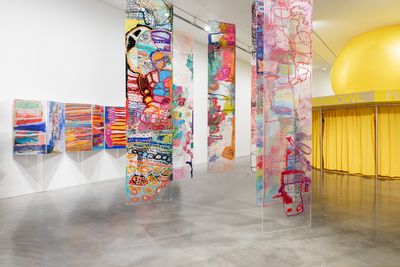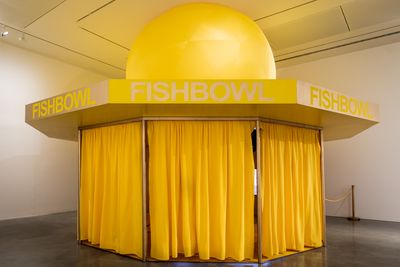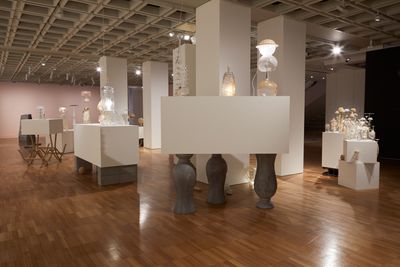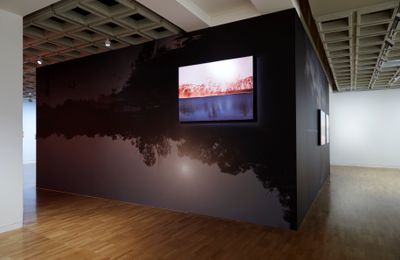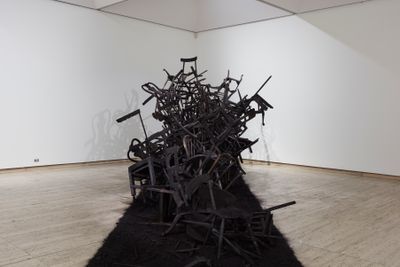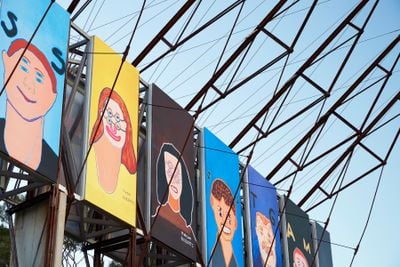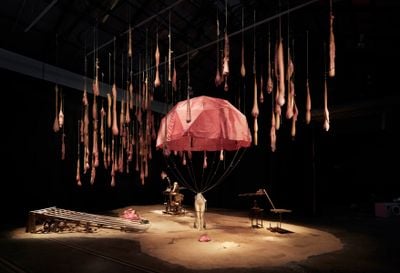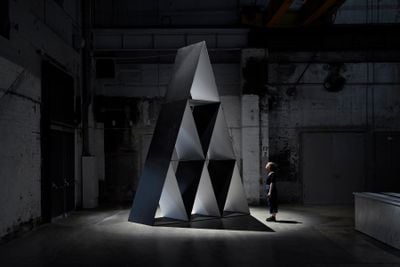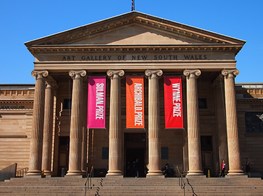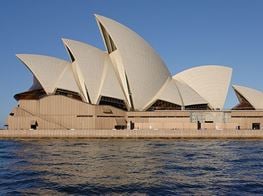The National 2019: New Australian Art
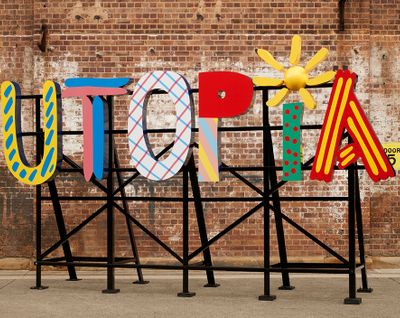
Sam Cranstoun, Utopia (2019). Exhibition view: The National 2019: New Australian Art, Carriageworks, Sydney (29 March–23 June 2019). © Sam Cranstoun. Courtesy the artist and Carriageworks. Photo: Zan Wimberley.
The National 2019: New Australian Art features work by 70 contemporary Australia-based artists split across three venues: the Art Gallery of New South Wales (AGNSW), Carriageworks, and the Museum of Contemporary Art Australia (MCA) (29 March–21 July 2019), as curated by Isobel Parker Philip, curator of photographs at AGNSW; Daniel Mudie Cunningham, director of programmes at Carriageworks; and MCA curators Clothilde Bullen and Anna Davis.
While the curators rejected the notion that this is a survey show during its media launch, the biennial exhibition—the second of three scheduled editions, with the third slated for 2021—does offer insight into how artists in Australia, not to mention a new generation of curators, are thinking about the times in which we live.
The MCA exhibition opens with a collection of Janet Fieldhouse's beautiful ceramic objects from three different series of works—'Mark and Memory', 'Hybrid', and 'Confluence'. Displayed in vitrines and set against dramatic black gallery walls, Fieldhouse's works pay tribute to her Torres Strait Islander heritage by transferring traditional designs and languages to clay as a way of retaining and sharing forms of knowledge. Nearby, Hannah Brontë's Heala (2018) draws viewers in first through sound; a melodic rhythm based on the artist's own heartbeat can be heard upon entering the gallery, where a luminous orange curtain drawn into a womb-like semi-circle is installed. The curtain surrounds a circle of sand pooled directly on the floor upon which a video is projected. We see a group of women from different generations, one of whom is heavily pregnant, all dressed in orange upon a beach. These women dance and thrash in the water while singing along to the soundtrack. While the work deals with the grief of sexual assault, it ultimately feels like a catharsis, a celebration of female and matriarchal resilience.
Heala sets the tone for the rest of the show, which shifts the power dynamics of the white cube to give voice to women, First Nations artists, and people of colour. Over 60 percent of artists are female identifying, with strong representation by First Nations female artists such as Hannah Brontë, Amrita Hepi, Amala Groom, Kaylene Whiskey, and The Unbound Collective.
Music is present throughout the MCA show, from Tina Havelock Stevens' post-punk-inflected video The Rapids (2019), in which the artist is seen playing her drum kit on a river shoreline in the Philippines; to Lucas Abela's interactive sound installation Fort Thunder (2018), a series of sonic structures connected to analogue sound processors that emit unexpected noises when touched. Elsewhere, the rhythm of line and colour is expressed in acrylic on Perspex sheets as part of Martuwarra (2018) by Daisy Japulija, Sonia Kurarra, Tjigila Nada Rawlins, and Ms Uhl; artists from Fitzroy Crossing in Western Australia who work from the studio of Juniper Guwardi Ngadu Residential Care.
Kaylene Whiskey, like many artists in this exhibition, is carving out new rituals from the old. The artist's whimsical oil on canvas paintings, along with her water-based enamel depictions on decommissioned road signs combine the traditional culture of her community's elders with Western pop culture references, from Dolly Parton to ABBA and Michael Jackson; these paintings speak to the hybrid cultural reality of living in remote Indigenous communities in contemporary Australia.
This hybrid experience extends to many other communities in Australia, particularly through migration, as depicted in Eugenia Lim's installation The Australian Ugliness (2018). This three-channel video is set inside a large yellow dome inspired by Ron Robertson-Swann's controversial public sculpture Vault (1980), which was lampooned at the time and nicknamed 'yellow peril', an uncomfortable reminder of Australia's embedded casual racism. Donning a gold suit, Lim creates a tongue-in-cheek fictional narrative in the film, shifting identities as tourist, student, client, property investor, and resident across Australian landmark sites such as Bondi Beach, the Melbourne Museum, the Opera House, and the Sirius Building. Buildings 'come to life' through the costumed choreography of atypical bodies (queer, ageing, plus-size) and Lim's negotiation of these architectural sites using her own body, responding to the sometimes-alien experience of being Asian-Australian.
In the next room are two substantial works that deal with the notion of memory and loss. Abdul-Rahman Abdullah's Pretty Beach (2019) is a deeply moving tribute made out of handcrafted stingrays swimming beneath a shower of crystals that reflects on his grandfather's suicide by freezing in time a moment from his childhood where he and his family witnessed a circle of stingrays gliding through the shallow water. Across from this is Kunmanara (Mumu Mike) Williams' Kamantaku Tjukurpa wiya (The Government doesn't have Tjurkurpa.) (2018): a series of paintings on repurposed canvas mailbags that map the conflicts between Commonwealth and traditional land rights in the Anangu Pitjantjatjara Yankunytjatjara (APY) region of South Australia.
At AGNSW, curator Isobel Parker Philip's version of The National 2019 has a distinctly different vision from the MCA, with a strong connection to materiality, formalism, and shape-shifting, where objects challenge their physical boundaries and transform into something new. This is a more nebulous display that crosses from the museum's entrance and carries down the stairs to the contemporary gallery spaces, and what is striking about this particular ensemble is the sensitivity to how stories are told through images and materials.
Situated inside the classically designed alcoves on either side of the AGNSW's vestibule are two clusters of plaster busts featuring the same anonymous face, which form Part 1, The Emissaries: Keepers of Our Stories from The Ongoing Remains (2019) by Melbourne-based Andrew Hazewinkel. These busts are clustered again along the grand entrance court opposite Tom Polo's immense wall painting When Windows Become Walls (2019), which occupies the vast entrance to the 19th century gallery spaces. The work contains words such as 'imagine', 'light', and 'leaks' floating above large placards painted in the artist's signature gestural style and resting upon a deep blue and red backdrop. Polo creates a theatrical environment where the painting becomes a prop on the institutional stage.
Downstairs in the contemporary galleries is Essays in Vibrational Poetics (2019) by Fayen d'Evie: an installation of stones of various sizes inlayed with messages written in braille based on various transcriptions of the phrase, that read: 'we call to you with vibrational poetics, and so the story carries on and on...' D'Evie choreographs the audience through their sense of touch in an attempt to shift the way art is experienced away from sight and towards new forms of non-visible languages. Also on show in this section is Koji Ryui's large installation TOT (2018–2019), which consists of everyday objects like drinking glasses, lamps, and chairs transformed into an alchemy of sculptural elements cast in sand. Both works are like archaeological discoveries of the contemporary moment, unearthed as objects of uncertain materiality and purpose.
The AGNSW exhibition becomes more political the deeper the viewer follows the trail. Peta Clancy's seemingly banal photographs of Australian landscapes in the series 'Undercurrent' (2018–2019) document an underwater massacre site on Dja Dja Wurrung Country, which was inundated when a weir was constructed on the Loddon River. Brisbane-based artist Robert Andrew has created two large-scale works concerned with reclaiming Indigenous languages by implicitly linking them to land. In his work, A Connective Reveal – Language (2019), a drawing machine slowly reveals the Gadigal word 'buduwa', meaning to warm your fingers over a fire then gently squeezing another person's fingers.
A Connective Reveal – Land (2019), Andrew's second installation, consists of two kinetic sculptures made of soil pillars that gradually collapse over the duration of the exhibition, returning to piles of soil on the ground, a poetic gesture that speaks to the continuous erasure of Indigenous histories.
Stories abound in Eliza Hutchison's large-scale photographs depicting glitched out, pixelated digital images sourced from the internet and social media, titled 'The difference between the eternal and the infinite' (2019). Scenes are disrupted and people are distorted; trapped in fractured narratives reflecting on the speed with which information is generated, regurgitated, and spat out again. Just beyond this is Rushdi Anwar's monumental sculpture Irhal (Expel), Hope and the Sorrow of Displacement (2013–ongoing) composed of blackened wooden chairs, stacked perilously on top of each other atop a carpet of charcoal remains. As a Kurdish refugee, Anwar reflects on his own individual experience of war and displacement, a kind of meditation on memory and collective grief.
At Carriageworks, the exhibition opens with a series of joyous, large-scale portraits of Thom Roberts' imagined 'train-people'—portraits of the personalities Roberts has attributed to different trains, which occupy a deep fascination for the artist—that hang along the Eveleigh entranceway ('Thom Roberts Counts Trains', 2019). Outside the gallery entrance, Sam Cranstoun's large-scale text sculpture Utopia (2019) riffs off Ken Done's notorious 'Australia' signs that were painted for Brisbane's Expo '88 with the aim to convey Australia as a vibrant modern paradise, with Cranstoun's version tapping into the darker stories hiding beneath sunny veneers. Inside, the exhibition is held within a narrow section of the immense Carriageworks industrial site.
Curator Daniel Mudie Cunningham brings his background in performance and research interests in pop culture and identity to the Carriageworks exhibition, which underscores a theatrical relationship to audience participation. Parallel to the gallery's entrance is Nat Thomas' Postcards from the Edge (2019), a mini Hollywood set where audience members are invited to lie atop a platform placed in front of a large screen. Projected onto the screen is a bustling New York street seen from above. When activated it appears as if the audience member is hanging off the edge of a skyscraper ready to fall. The work plays with the history of cinema from a female gaze and biennial-style spectacle—all the while acknowledging its own implicitness by being fodder for Instagram selfies galore.
Given the size of the building, much of the work is scaled up at Carriageworks, from Sean Rafferty's Cartonography (FNQ) (2019), a collection of fruit and vegetable boxes that span an entire wall, to Mish Meijers and Tricky Walsh's fictitious environment that orients around a persona constructed by the artists, Henri Papin. The Crocker Land Expedition (2018) is Henri Papin's re-creation of the 1913 voyage of the same name, which involved a search for land in the Arctic Circle that turned out to be a mirage. Populated by an army of disembodied limbs, we find ourselves on a desert island scattered with remnants of disaster. Taking up another wall is Eric Bridgeman's colourful assemblage of imagined shield paintings on timber and linen that speak to traditional and contemporary tribal warfare from the artist's heritage in Papua New Guinea, to Australia's obsession with rugby teams (Sikiram | Büng | Scrum, 2019).
Julie Fragar's This is Not a Dress Rehearsal: A Catalogue of Final Options (2019) is a speculative self-portrait painted entirely in black and white and fluorescent pink oils on board, which depicts the artist in death. Holding her own lifeless body as if recreating the Pietà, Fragar sees herself surrounded by a sea of imagined tragedies in which she possibly could die, from hanging to plane crashes. House of Discards (2019) by Tony Albert consists of a stack of supersized playing cards. Rather than the usual Kings, Queens, and Aces, Albert leaves the cards blank—black on one side and white on the other—as a disavowal of traditional colonial imperialism but also a proposition towards new forms of power and equality.
Cherine Fahd's series of black and white photographs, 'Apókryphos' (2018–2019), document her grandfather's funeral and create a compelling narrative about the ontological meaning of family grief and the nature of photography to allow us to witness events that we can never experience, yet somehow are inscribed within our collective memories.
Ultimately, The National 2019 proves itself by bringing a diversity of artist's voices, many of whom are from marginalised contexts, to think beyond Terry Smith's 'provincialism problem' and towards a new way of renegotiating how we see ourselves. But one of the most obvious issues with this project is its inward-looking focus at a time when we are seeing a real shift towards nationalism and conservatism in this country. While it's important to celebrate Australian artistic practices and highlight the work of local artists, it's equally important to think about Australian art in relation to international precursors so we aren't simply navel-gazing and ignoring what's happening beyond our own shores.
Of course, The National 2019, is part of a larger matrix of exhibitions such as the Adelaide Biennial, Tarrawarra Biennial, Ballarat's Biennale of Australian Art, as well as Australian Perspecta, a biennial event also held across venues such as the AGNSW and MCA from 1981 to 1999; and it remains to be seen what direction The National's final 2021 edition will take. Perhaps it's the hype around it and the way The National is often situated as an antithesis to the Biennale of Sydney that asks us to question if this is the kind of programme we need right now. When compared to seminal projects like the Asia Pacific Triennial of Contemporary Art, which since 1993 has radically altered our understanding of cultural identity across Australia and the region, it will be interesting to see what direction The National will take next, and what its impact will be. —[O]


